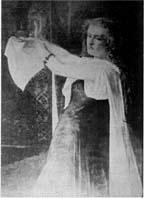TWH – Opportunities to knock on the doors of neighbors — with the expectation that they will provide a gift upon the opening of the door — has largely been relegated to trick-or-treating customs. But these visiting traditions extend back thousands of years in many parts of Europe. Typically the ritual involves some sort of exchange between the visitor and the host that bolster community ties, reinforce common values of culture and religion, and — at least symbolically — redistribute wealth.
Sarah Stockwell-Arthen, a member of the EarthSpirit community in western Massachusetts, has researched “visiting” and made efforts to recreate some of these practices in her neighborhood. That effort began with wassailing, for which many songs still survive and from which she could glean understanding about how and why it was done. She has also experimented with going a-maying and even knocked on doors around Samhain. She described herself as “passionate about community ritual,” and said that she was intrigued by how these practices were geographically rooted.The earliest wassail that she has found stems from the sixth century, when Anglo-Saxon princes toasted visiting warlords as an enactment of a pledge. However, the evidence of such door-to-door activity actually goes back much further still as Walter Burkert explains in Greek Religion:
Processions collecting gifts are widespread and still survive in some place in European popular culture. In ancient Greece customs of this kind make only a marginal appearance, but they certainly exist . . . even the priestess of Athena Polias went through the city collecting on certain days. On such occasions she wore the aegis of the goddess . . . In Sicily, herdsmen enter into the cities in a special procession, wearing deer antlers, hung about with bread in the shape of animals . . . as they collect gifts they announce in song the advent of peace, good luck, and health. Elsewhere, processions of this sort are staged by children . . . they sing: ‘The Eiresione brings figs and fat bread, honey in pots, and oil to rub down, a cup of strong wind so you go drunk to bed.’ [while on Rhodes they sing] ‘or we’ll carry off your door, or your wife.’ . . . To the promise of blessings there corresponds an almost sacral claim to gifts.
These “visting customs” were fading from common practice by the mid-19th century in Europe, and never caught on with quite so much fervor in the United States. However, this ancient exchange — blessings for gifts — is still evident in surviving folk practices today, and in the deliberate revival that Stockwell-Arthen has engaged in with her local community. Because the concept is not ingrained in modern culture, as it would have been even a century or two ago in northern Europe, it was necessary to talk to the neighbors and let them know what was expected. What was once transmitted from parents to children organically, was instead shared via email.
“My local community homesteads, focuses on sustainability, and is looking seriously at the future we are facing because of human action and how we have lived,” she said. There are many people in the hill towns of her part of commonwealth of Massachusetts who are “interested in connecting to the land, but are not Pagans.” That means a lot of fertile ground for exploring new ways to connect with the land and one another, and no shortage of people “interested in music, and dance, and creating blessings.”

A pot of wassail [via Wikimedia Commons]
For their part, the wassailers were encouraged to “dress up goofy” to reflect the spirit of merriment that they brought, and to make the visit as entertaining as possible. Only a handful of people ventured out in early January to do the deed; the time was chosen because its when the lengthening of daylight was first noticeable. However, their troupe grew as they went from house to house. And, it was no small feat, either: wassailing at about a dozen homes took them five hours.
All told, the midwinter efforts have gone well: Stockwell-Arthen was able to convince people to do it for a second year running, and she’s heard reports that some of those apple trees were more fruitful last year than they’d been in a long time.
Springtime blessings are also something that she’s exploring. Participants in last year’s Rites of Spring were visited by a cluster of brightly-dressed folk a-maying on the last day of that festival, to remind them when they needed to clear out of the camp. “We got lots of feedback about that,” she said. “People were working, tired, and loved remembering their purpose here.”
Attempts to do so in her neighborhood to bless the gardens have also been tried, but they did not succeed in making the traditional drink, syllabub, for that effort. “It had cream and wine in it, and it was gross,” Stockwell-Arthen recalled with a grimace.
Other visiting traditions focus on offerings such as soul cakes to be given to the ancestors; Stockwell-Arthen hasn’t added anything of that nature to her local repetoire as yet. She’s only found snippets of traditions that reference other times of year, such as the solstice, but she’s sure that it was something that was done somewhere in Europe, at some point in time.
“The songs tell you want to do,” she said. “I love that.” It makes reviving those visiting traditions for which the songs are lost all the more difficult, but not impossible.
Stockwell-Arthen’s work shows that there are ways to return to a relationship that is close to the land and to one’s neighbors, whether they are Pagan or not. It also demonstrates that, with a bit of enthusiasm, visiting traditions may just crop up in other parts of the country and the world, springing from different religious paths and performed in ways that are unique to the area, such as the blessing of California grapes or honoring spirits of the local mountain or desert. All it takes is a few friends, some creativity, and perhaps a little talent for singing and begging.
The Wild Hunt is not responsible for links to external content.
To join a conversation on this post:
Visit our The Wild Hunt subreddit! Point your favorite browser to https://www.reddit.com/r/The_Wild_Hunt_News/, then click “JOIN”. Make sure to click the bell, too, to be notified of new articles posted to our subreddit.


My Eastern Central Europe history class was taught by a woman who lived through the Soviet occupation of Eastern Poland during WWII. She shared that in Poland (in her youth), if a person came to the door on New Year’s Eve, that person was to be treated as an honored guest in the home. In her family the same applied to animals that show up at the door on New Year’s Eve. She mentioned that at one time people were dropping off unwanted cats on New Year’s Eve because her family would take them in and care for them.
This is true in the Byelorussian/Polish/Ukrainian customs as well. Furthermore, at the Kutia (Lituanian word) custom the night before Christmas, a place was left at the table for the “departed”.
Pingback: Reviving the Ancient Visiting Traditions of Europe | The Wild Hunt | Green Dragon's Cave, Author and Artist